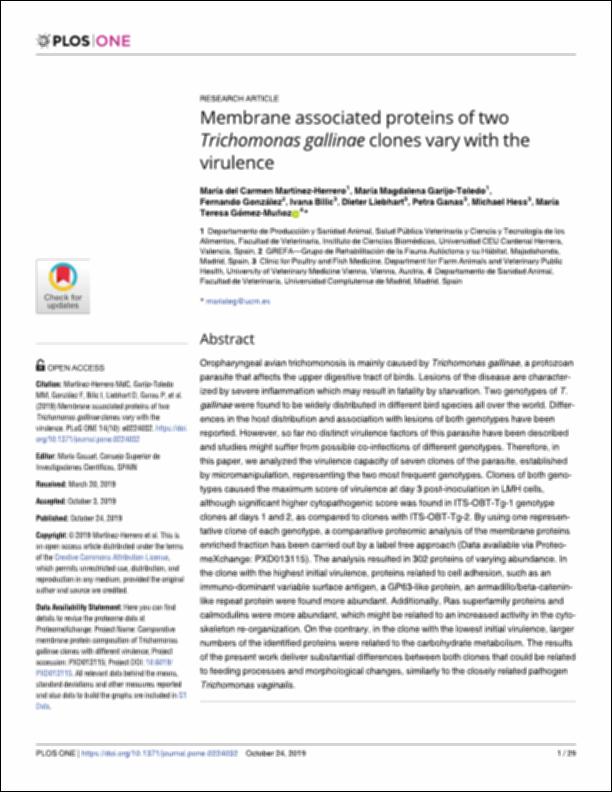Por favor, use este identificador para citar o enlazar este ítem:
http://hdl.handle.net/10637/13873Membrane associated proteins of two "Trichomonas gallinae" clones vary with the virulence
| Título : | Membrane associated proteins of two "Trichomonas gallinae" clones vary with the virulence |
| Autor : | Martínez Herrero, María del Carmen Garijo Toledo, María Magdalena González González, Fernando Bilic, Ivana Liebhart, Dieter Ganas, Petra Hess, Michael Gómez Muñoz, María Teresa |
| Materias: | Tricomoniasis vaginal.; Trichomonas vaginalis.; Aves - Enfermedades parasitarias.; Parasitología veterinaria.; Birds - Parasites.; Trichomonosis in birds.; Aves - Parásitos. |
| Editorial : | PLOS |
| Citación : | Martínez-Herrero, M., Garijo-Toledo, M. M., González, F., Bilic, I., Liebhart, D., Ganas, P., Hess, M. & Gómez-Muñoz, M. T. (2019). Membrane associated proteins of two "Trichomonas gallinae" clones vary with the virulence. PloS One, vol. 14, i. 10 (24 oct.), art. e0224032. DOI: https://doi.org/10.1371/journal.pone.0224032 |
| Resumen : | Oropharyngeal avian trichomonosis is mainly caused by Trichomonas gallinae, a protozoan parasite that affects the upper digestive tract of birds. Lesions of the disease are characterized by severe inflammation which may result in fatality by starvation. Two genotypes of T. gallinae were found to be widely distributed in different bird species all over the world. Differences in the host distribution and association with lesions of both genotypes have been reported. However, so far no distinct virulence factors of this parasite have been described and studies might suffer from possible co-infections of different genotypes. Therefore, in this paper, we analyzed the virulence capacity of seven clones of the parasite, established by micromanipulation, representing the two most frequent genotypes. Clones of both genotypes caused the maximum score of virulence at day 3 post-inoculation in LMH cells, although significant higher cytopathogenic score was found in ITS-OBT-Tg-1 genotype clones at days 1 and 2, as compared to clones with ITS-OBT-Tg-2. By using one representative clone of each genotype, a comparative proteomic analysis of the membrane proteins enriched fraction has been carried out by a label free approach (Data available via ProteomeXchange: PXD013115). The analysis resulted in 302 proteins of varying abundance. In the clone with the highest initial virulence, proteins related to cell adhesion, such as an immuno-dominant variable surface antigen, a GP63-like protein, an armadillo/beta-cateninlike repeat protein were found more abundant. Additionally, Ras superfamily proteins and calmodulins were more abundant, which might be related to an increased activity in the cytoskeleton re-organization. On the contrary, in the clone with the lowest initial virulence, larger numbers of the identified proteins were related to the carbohydrate metabolism. The results of the present work deliver substantial differences between both clones that could be related to feeding processes and morphological changes, similarly to the closely related pathogen Trichomonas vaginalis. |
| Descripción : | Este artículo se encuentra disponible en la siguiente URL: https://journals.plos.org/plosone/article?id=10.1371/journal.pone.0224032 |
| URI : | http://hdl.handle.net/10637/13873 |
| Derechos: | http://creativecommons.org/licenses/by/4.0/deed.es |
| ISSN : | 1932-6203 (Electrónico) |
| Fecha de publicación : | 24-oct-2019 |
| Centro : | Universidad Cardenal Herrera-CEU |
| Aparece en las colecciones: | Dpto. Producción y Sanidad Animal, Salud Pública Veterinaria y Ciencia y Tecnología de los Alimentos |
Los ítems de DSpace están protegidos por copyright, con todos los derechos reservados, a menos que se indique lo contrario.


